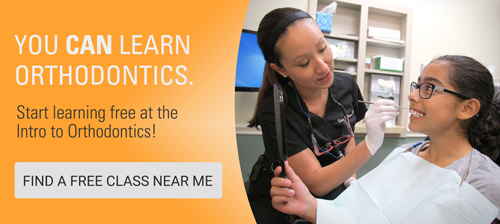If you have never treated an orthodontic patient before, selecting your first case may feel overwhelming. Luckily with the right support, there are many cases that you can start treating with great success this year.
We put together this list of 10 types of cases to help you know what to look for when choosing your first orthodontic patients. Even as a beginner in the POS program, you are capable of starting quality treatment for the following types of cases.
1. Pseudo Class III

Although this case may look intimidating, it's actually a much simpler case than you'd expect. If you choose to take this case on this year, you'll be able to greatly affect your patient's appearance. Although you'll learn more about pseudo classes and mandibular posturing in the POS series, make sure to have an instructor look at your case before you start treatment. Since appearances can be misleading, it's always a good idea to check with an expert.
2. Protrusion, mild crowding, mild Class II

This is an easy case that you can excel at. You can take on most mild Class II cases as an orthodontic beginner. 2mm - 5mm of Class II is considered mild to moderate. Although as a beginner you may not be as efficient as this, treatment finished in under a year.
3. Moderate crowding, deep bite

You can help moderate crowding patients (patients with crowding in the upper and/or lower arches up to 4mm - 5mm.) This simple case was treated within 12 months.
4. Crowding, Class II, narrow smile

This patient has moderate crowding and a narrow arch, making her smile less attractive and her teeth look darker than they are. You can use an expanding arch shape to help you get more room and a nice finish. This case was eventually treated in 14 months with a non extraction treatment plan.
5. Mild crowding, mild Class II, mild open bite

Another Class II crowding case. Yes, you can do this one too even with mild open bite. This case was treated in 14 months with four bicuspid extractions.
6. Young patients with bite issues

You should start helping your young patients as soon as you can. Patients like this 9.5 year old really need your intervention to prevent long term bite issues and avoid costly and invasive surgery. Look for young patients from 7 years old who have strong Class II and III, crowding (or small jaws), destructive habits (e.g. thumb sucking, tongue thrust). Once you learn how to identify the child's maturity and the appropriate appliances, you can greatly affect these kids' lives with Phase I treatment. See the amazing results of this Class III interceptive treatment
7. High upper canines, crowding, mild Class II, mild deep bite

Believe or not, the common "fangs" case is a good one to start. Although the canines may seem very high, brackets and wire can align the teeth in an impressive way. This case has 4mm of Class II and 8mm of upper crowding but almost no crowding in the lower (which makes it easier for you).
8. Moderate crowding, mild Class II

You can be confident to start cases like this with a good amount of crowding. This case has 7mm and 9mm of crowding in the upper and lower arches. You may need to present an extraction treatment plan and spend more time since there's more crowding, but you can definitely help these patients get a significant improvement in their smiles.
9. Rotated teeth, missing two teeth

Especially if the patient has a good bite, you can help patients who do not like their crooked teeth like this case. You may have noticed that they were missing two teeth, but that's ok, you can still treat this one successfully with good planning!
10. Moderate spacing, moderate open bite

Although an open bite case like this may have underlying myofunctional habits to fix (like potential tongue thrust), you can plan for habit correction and start helping this patient with orthodontics this year.
Caveat: If you see similar cases but there are periodontal issues, strong asymmetry, or behavioral "red flags" (with the patient or parents), your instructor may recommend you to wait until you get more experience for these.
You can find many of these types of cases already in your practice. If you're unsure if a certain case may be a good first case for you, ask below or bring photos to your seminar! POS instructors are happy to take a quick look at your records and tell you whether or not to move forward.
Want to learn more about orthodontic training with POS? Attend one of 32 free Intro to Orthodontics Seminars around the world. See locations and schedule here.
Got any questions about these 10 cases? Ask in the comments below.


